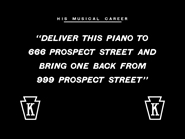Step 4 - Restoration planning and the preservation route
Planning the printing, grading and cutting together of preservation masters, printing materials and release prints (and digital tapes) is a highly skilled job. It requires years of experience and a complex series of processes, which need to be done in sequence or expensive mistakes can be made.
Although the prints and negatives gathered together for the project are nominally copies of A Film Johnnie, they differ greatly in terms of definition, contrast and density. The aim of the printing work is to copy each source in the best quality and to make them match each other as closely as possible. This work on printing and developing the new negatives plays a crucial part in determining the evenness of the final print.
To assemble the restored version, Claire needed new negatives that she could cut together in the order she had identified. Since four of the six copies were negatives, they needed to be printed as fine grain low contrast positives from which duplicate negatives could be made.
Film printers come in a variety of designs, each using a combination of characteristics to achieve certain aims. To print the source copies of A Film Johnnie the following types of printer were used.
The two nitrate prints of A Film Johnnie were duplicated on a 'wet-gate' printer. In this printer, at the moment of exposure, the original is immersed in a liquid that has the same refractive index as film and so the light is not bent as it hits the scratches. This conceals scratches to a considerable degree and is often used in archive work. This particular printer is in addition an 'optical' printer, which means that the original is projected through a lens system to be photographed onto the new stock. In this case, the 'printer' is in fact a combination of a projector and a camera, with all the usual photographic controls of a camera.
The negatives were printed on a 'step contact' printer. In this case, the original and the raw stock are held in close contact at the point of exposure. In a step printer, the films are moved one frame at a time and a shutter masks the lamp during that time. This is in contrast to a continuous printer, which moves the films continuously past an illuminated slit. The step printer has advantages in terms of image steadiness and definition. The negatives were not badly scratched and could therefore be printed dry. Both the step and the optical printers make allowance for film shrinkage.
Besides the printing work, reproductions of the original Keystone titles and intertitles were composed in Photoshop and shot back to film.


These individual frames were then printed as the required length of negative, for cutting with the picture. These reproductions were scans from original Keystone negatives that had been cleaned. Alphabets in the correct fonts were created for the main and end titles and the intertitles. Once the correct wording was established, the reconstructed titles in Keystone's original design were made.

